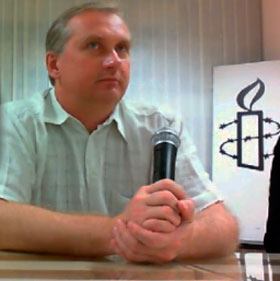Pavel Sapelka: Graffiti neither violates public order nor expresses disrespect for society
On August 11, law enforcement officers detained five youth activists: Maksim Piakarski, Vadzim Zharomski, Viachaslau Kasinerau, Yaraslau Ulyianenkau and a citizen of the Russian Federation Pavel (last name unknown). The latter two were later released on bail, while Maksim Piakarski and Vadzim Zharomski were taken into custody before charges were brought against them. Viachaslau Kasinerau is in custody in hospital, where he was placed with a double fracture of the jaw after he was beaten by policemen.
The prosecution and detention were preceded by a criminal case opened by the Minsk Office of the Investigative Committee under Part 2, Art. 339 of the Criminal Code ("malicious hooliganism"), which in turn stemmed from political graffiti painted by unknown persons in two locations in Minsk, and Art. 341 of the Criminal Code ("desecration of facilities and property damage"), an episode dealing with the destruction of property owned by an individual entrepreneur (a big board depicting police officers) in another location in Minsk.
Lawyer Pavel Sapelka shares his opinion on the criminal cases against the new political prisoners:
“The emergence of new political prisoners makes us analyze some aspects of criminal prosecution, which cause debate in the society and in the media. So far, the position of the detained youth activists has not been voiced, but it is possible to analyze the basis for opening the criminal cases. First, I would like to focus on a simple, from my point of view, episode: inscribing graffiti with the words "Belarus Must Be Belarusian" with the images of an ornament, crossed out hammer and sickle, and crossed-out swastikas. The decision to open the criminal investigation mentions other symbols and images. However, it is not yet clear what the investigators meant.
This action is qualified under Part 2, Article 339 of the Criminal Code as ‘malicious hooliganism’.
What is hooliganism in the legal sense? Deliberate actions grossly violating public order and expressing clear disrespect for society, accompanied by violence or threat of violence or destruction or damage of other person’s property, or committed with exceptional cynicism.
Part 2 the article provides for punishment for the same actions committed repeatedly or by a group of persons or a person associated with resisting the person who attempted to stop the act of hooliganism, or involving the infliction of less serious injuries.
Therefore, the first thing to be established when qualifying the actions as hooliganism is a fact of gross violation of public order, accompanied by sheer disrespect for society. And even these actions alone do not entail criminal responsibility if not accompanied by violence or a threat of violence or damage to property, or do not demonstrate exceptional cynicism.
I can safely say that the inscription and the images do not violate public order and roughly express explicit disrespect for society: they have no offensive content, tabooed expressions and definitions. Therefore, further discussion regarding the damage of property does not make sense.
The motive of inscribing such inscriptions under these circumstances cannot be of hooliganism-related nature, being merely a means of expression. The inscription could have been found vandalistic if it were left, for example, on a monument that has real artistic value.
The Constitution of Belarus and the Covenant on Civil and Political Rights obliges the state to respect the right to freedom of expression, if it is peaceful in nature, does not infringe on state security or public safety and morality.
Legislators have established a penalty for the willful destruction or damage of property without hooliganism motives, while criminal liability is provided for causing large-scale damage (more than 40 basic units, that is, 7.2 million rubles). There are criminal penalties for the desecration of buildings or other structures with cynical words or pictures (but it is not the current case), there is a responsibility for damage to the property of public transport or in other public places. All of these cases are crimes which the law labels as offenses that do not pose great danger to society and the measure of restraint in the form of detention cannot be imposed in these cases.
Of course, this inscription can be frowned at, for example, by the owner of the building, and he, not sharing the opinion of the author, wants to remove the sign and suffers material losses. In this case, of course, the author, i.e. the artist, should bear civil liability, and the court can recover compensation for damages.
The second episode of malicious hooliganism stems from the inscription “Revolution of Consciousness, It Is Near At Hand” with the image of a man holding a Molotov cocktail. Everything that has been said before can be as well applied to this episode. Of course, it is also a manifestation of expression, which is not accompanied by direct calls to commit unlawful acts. This inscription, as well as the painting, is not a call and it is from this point of view that they should be evaluated by the agency conducting the criminal investigation. All sorts of assumptions and conjectures as to the meaning of the inscriptions and images are inadmissible during the investigation of the criminal case, because they violate the presumption of innocence.”
Source: palitviazni.info


















